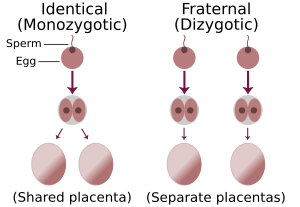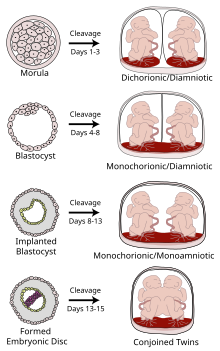www.wikipedia.com
Zygosity is the degree of identity in the genome of twins. There are five common variations of twinning. The three most common variations are all fraternal (dizygotic):
- Male–female twins are the most common result, 50 percent of fraternal twins and the most common grouping of twins.
- Female–female fraternal twins (sometimes called "sororal twins")
- Male–male fraternal twins
- Female–female identical twins
- Male–male identical twins (least common)
Fraternal (dizygotic) twins
Fraternal or dizygotic (DZ) twins (also referred to as "non-identical twins", "dissimilar twins", "biovular twins", and, in cases of females, occasionally sororal twins) usually occur when two fertilized eggs are implanted in the uterus wall at the same time. When two eggs are independently fertilized by two different sperm cells, fraternal twins result. The two eggs, or ova, form two zygotes, hence the terms dizygotic and biovular.Fraternal twins, like any other siblings, have an extremely small chance of having the same chromosome profile. Like any other siblings, fraternal twins may look similar, particularly given that they are the same age. However, fraternal twins may also look very different from each other. They may be of different sexes or the same sex. The same holds true for brothers and sisters from the same parents, meaning that fraternal twins are simply brothers and/or sisters who happen to be the same age.
Studies show that there is a genetic basis for fraternal twinning. However, it is only their mother that has any effect on the chances of having fraternal twins; there is no known mechanism for a father to cause the release of more than one ovum. Dizygotic twinning ranges from six per thousand births in Japan (similar to the rate of monozygotic twins) to 14 and more per thousand in some African countries.[6]
Fraternal twins are also more common for older mothers, with twinning rates doubling in mothers over the age of 35.[11] With the advent of technologies and techniques to assist women in getting pregnant, the rate of fraternals has increased markedly.
Identical (monozygotic) twins

Comparison of zygote development in identical and fraternal twins. In the uterus, a majority of identical twins (60–70%) share the same placenta but have separate amniotic sacs. In 18–30% of identical twins each fetus has a separate placenta and a separate amniotic sac. A small number (1–2%) of identical twins share the same placenta and amniotic sac. Fraternal twins each have their own placenta and own amniotic sac.
There are an estimated 11 million sets of identical twins and triplets in the world today.
Mechanism
Regarding spontaneous or natural monozygotic twinning, a recent theory posits that identical twins are formed after a blastocyst essentially collapses, splitting the progenitor cells (those that contain the body's fundamental genetic material) in half, leaving the same genetic material divided in two on opposite sides of the embryo. Eventually, two separate fetuses develop.[12] Spontaneous division of the zygote into two embryos is not considered to be a hereditary trait, but rather a spontaneous or random event.[11][13]Identical twins may also be created artificially by embryo splitting. It can be used as an expansion of IVF to increase the number of available embryos for embryo transfer.[14]
Incidence
Monozygotic twinning occurs in birthing at a rate of about three in every 1000 deliveries worldwide.[13]The likelihood of a single fertilization resulting in identical twins is uniformly distributed in all populations around the world.[11] This is in marked contrast to fraternal twinning, which ranges from about six per thousand births in Japan (almost similar to the rate of identical twins, which is around 4–5) to 15 and more per thousand in some parts of India[15] and up to 24 in the US,[citation needed] which might mainly be due to IVF (in vitro fertilization). The exact cause for the splitting of a zygote or embryo is unknown.
In-vitro fertilization techniques are more likely to create twins. Only about three pairs of twins per 1,000 deliveries occur as a result of natural conception, while for IVF deliveries, there are nearly 21 pairs of twins for every 1,000.[16]
Genetic and epigenetic similarity
Identical twins are genetically identical (unless there has been a mutation during development) and they are always the same sex. On rare occasions, identical twins may express different phenotypes (normally due to an environmental factor or the deactivation of different X chromosomes in female identical twins), and in some extremely rare cases, due to aneuploidy, twins may express different sexual phenotypes, normally due to an XXY Klinefelter's syndrome zygote splitting unevenly.[17][18]Identical twins actually have only nearly identical DNA, and differing environmental influences throughout their lives affect which genes are switched on or off. This is called epigenetic modification. A study of 80 pairs of human twins ranging in age from three to 74 showed that the youngest twins have relatively few epigenetic differences. The number of epigenetic differences between identical twins increases with age. Fifty-year-old twins had over three times the epigenetic difference of three-year-old twins. Twins who had spent their lives apart (such as those adopted by two different sets of parents at birth) had the greatest difference.[19] However, certain characteristics become more alike as twins age, such as IQ and personality.[20][21] This phenomenon illustrates the influence of genetics in many aspects of human characteristics and behavior.[citation needed]
Phenotype similarity
Contrary to common opinion, identical twins are not always of the same phenotypical sex. There have been described cases where monozygocity resulted in 46,XO (i.e. female with Turner syndrome) and 46,XY (i.e. male). This is thought to be due to unequal distribution of zygotic protoplasm. However, as a rule, traits and physical appearances of MZ twins are very similar.Identical twins look alike, although they do not have the same fingerprints (which are environmental as well as genetic). As they mature, identical twins often become less alike because of lifestyle choices or external influences. The children of identical twins would test genetically as half-siblings rather than first cousins.
Half-identical twins
Half-identical or semi-identical twins (also referred to as "half twins") are the result of a very rare form of twinning in which the twins inherit exactly the same genes from their mother but different genes from their father. Although examples of half-identical twins have been found, the exact mechanism of their conception is not well-understood, but could theoretically occur in polar body twinning where sperm cells fertilize both the ovum and the second polar body.This situation is not the same as the common form of fraternal twinning, in which two genetically different ova are fertilized by two genetically different sperm. In this case, the ova are genetically identical.
Types
There are two mechanisms by which this might happen:- Polar twins (or "polar body twins"), where two sperm fertilize an ovum, one of the two fertilizing a polar body;[22] or where an ovum splits into identical copies, one containing a polar body, prior to fertilization, allowing it to be fertilized by two different sperm.[23][24]
- Sesquizygotic twins, where two sperm fertilize the one ovum, forming a triploid, and then splitting.[25]
Incidence
A 1981 study of a dead triploid XXX twin fetus without a heart showed that although its fetal development suggested that it was an identical twin, as it shared a placenta with its healthy twin, tests revealed that it was likely a polar body twin. The authors were unable to predict whether a healthy fetus could result from a polar body twinning.[26] In 2003 a study argued that many cases of triploidity arise from semi-identical twinning.[27] In 2007, a study reported a case of a pair of living twins, one a hermaphrodite and one a phenotypical male. The twins were both found to be chimeras and to share all of their maternal DNA but only half of their father's DNA. The exact mechanism of fertilization could not be determined but the study stated that it was unlikely to be a case of polar body twinning.[28]Degree of separation
In very rare cases, twins become conjoined twins. Furthermore, there can be various degrees of shared environment of twins in the womb, potentially leading to pregnancy complications.
It is a common misconception that two placentas means twins are dizygotic (non-identical). But if monozygotic twins separate early enough, the arrangement of sacs and placentas in utero is indistinguishable from dizygotic twins.
| Type | Description | Day |
|---|---|---|
| Dichorionic-Diamniotic | Normally, twins have two separate (di- being a numerical prefix for two) chorions and amniotic sacs, termed Dichorionic-Diamniotic or "DiDi". It occurs in almost all cases of dizygotic twins (except in very rare cases of fusion between their blastocysts[29] ), in 99.7% of all pregnancies,[30] and in 18–36%[31] (or around 25%[29]) of monozygotic (identical) twins. DiDi twins have the lowest mortality risk at about 9 percent, although that is still significantly higher than that of singletons.[32] | Dichorionic-Diamniotic twins form when splitting takes place by the third day after fertilization.[29] |
| Monochorionic-Diamniotic | Monochorionic twins share the same placenta. Monochorionic twins generally have two amniotic sacs (called Monochorionic-Diamniotic "MoDi"), which occurs in 60–70% of the pregnancies with monozygotic twins.[31] Monochorionic-Diamniotic twins are almost always monozygotic, with a few exceptions where the blastocysts have fused.[29] | Days 4-8 |
| Monochorionic-Monoamniotic | Sometimes, monochorionic twins also share the same amnion. This situation occurs in 1–2% of monozygotic twin pregnancies.[31] Monoamniotic twins are always monozygotic (identical twins).[33] The survival rate for monoamniotic twins is somewhere between 50%[33] to 60%.[34] Consequently, if twins are monoamniotic that means that the two babies will be sharing a placenta and as a result, due to the small capacity of sharing a sac, the umbilical cord has an increased chance of being tangled around the babies. Because of this, there is an increased chance that the newborns may be miscarried or suffer from cerebral palsy due to the lack of oxygen. | Monoamniotic twins occur when the split takes place after the ninth day after fertilization.[29] |
| Conjoined twins | When the division of the developing zygote into 2 embryos occurs, 99% of the time it is within 8 days of fertilization. Mortality is highest for conjoined twins due to the many complications resulting from shared organs. | If the division of the zygote occurs later than the 12 days then conjoined twins are usually the result. |



Another nice post.......thanks for sharing.
ReplyDelete